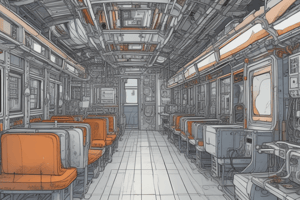Podcast
Questions and Answers
What is the purpose of interconnection in a computer system?
What is the purpose of interconnection in a computer system?
- To allow communication between different units such as memory, input/output, and CPU (correct)
- To provide power supply to the computer units
- To physically connect the computer modules together
- To cool down the computer units during operation
What is the function of an I/O module in a computer system?
What is the function of an I/O module in a computer system?
- Receive addresses from peripheral and send data to computer
- Write out data after processing
- Read instructions and data from memory
- Receive data from computer and send data to peripheral (correct)
What does a CPU primarily do in the context of interconnection?
What does a CPU primarily do in the context of interconnection?
- Writes out data and sends control signals to peripherals
- Reads instructions and data, and receives interrupts (correct)
- Receives addresses from the computer
- Receives data from and sends data to the I/O module
What is a bus in the context of computer architecture?
What is a bus in the context of computer architecture?
What is the main characteristic of a 32-bit data bus?
What is the main characteristic of a 32-bit data bus?
Which type of unit receives addresses and control signals in a computer system?
Which type of unit receives addresses and control signals in a computer system?
What does the data bus carry at this level?
What does the data bus carry at this level?
In bus architecture, what does the address bus identify?
In bus architecture, what does the address bus identify?
What is the key determinant of performance in bus architecture?
What is the key determinant of performance in bus architecture?
What does the bus width determine in a system?
What does the bus width determine in a system?
What problems are associated with lots of devices on a single bus?
What problems are associated with lots of devices on a single bus?
Which type of bus has separate data and address lines?
Which type of bus has separate data and address lines?
In bus arbitration, what does centralised arbitration involve?
In bus arbitration, what does centralised arbitration involve?
What does the control bus carry in terms of information?
What does the control bus carry in terms of information?
What is the role of an I/O module in a computer system?
What is the role of an I/O module in a computer system?
Why are peripherals not connected directly to the system bus?
Why are peripherals not connected directly to the system bus?
What types of devices are typically interfaced with an I/O module?
What types of devices are typically interfaced with an I/O module?
What is the primary reason for the data transfer rate of peripherals being slower than that of the CPU and RAM?
What is the primary reason for the data transfer rate of peripherals being slower than that of the CPU and RAM?
What is the purpose of Interrupt Driven I/O?
What is the purpose of Interrupt Driven I/O?
What technique allows the CPU to have direct control over I/O?
What technique allows the CPU to have direct control over I/O?
What is the function of the Control & Timing block in the External Device Block Diagram?
What is the function of the Control & Timing block in the External Device Block Diagram?
What is the main difference between Memory mapped I/O and Isolated I/O?
What is the main difference between Memory mapped I/O and Isolated I/O?
What is the role of the 8259A interrupt controller in the context of an 8086-based system?
What is the role of the 8259A interrupt controller in the context of an 8086-based system?
What is the purpose of the External Device Block Diagram in a computer system?
What is the purpose of the External Device Block Diagram in a computer system?
In bus architecture, what does isolated I/O require that memory mapped I/O does not?
In bus architecture, what does isolated I/O require that memory mapped I/O does not?
What is the primary function of Programmed Interrupt Driven I/O?
What is the primary function of Programmed Interrupt Driven I/O?
Flashcards are hidden until you start studying




